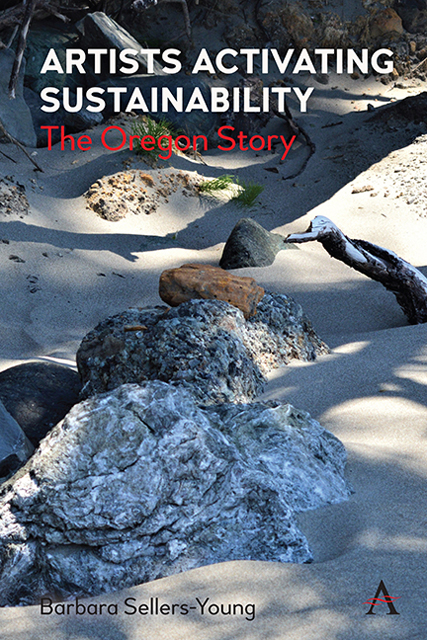Book contents
- Frontmatter
- Dedication
- Contents
- Acknowledgments
- List of Figures
- Introduction: Art, Environment and Metaphor
- 1 Environmental Activism, Arts and the Land of Eden Landscape One: High Desert Basin and Range
- Landscape One High Desert Basin and Range
- Landscape Two Columbia Gorge and Plateau
- Landscape Three Cascade Range
- Landscape Four The Willamette Valley
- Landscape Five Rogue River Valley
- Landscape Six Oregon Coast and Coast Range
- Index
4 - James Lavadour and Crow’s Shadow Institute of the Arts
Published online by Cambridge University Press: 10 January 2023
- Frontmatter
- Dedication
- Contents
- Acknowledgments
- List of Figures
- Introduction: Art, Environment and Metaphor
- 1 Environmental Activism, Arts and the Land of Eden Landscape One: High Desert Basin and Range
- Landscape One High Desert Basin and Range
- Landscape Two Columbia Gorge and Plateau
- Landscape Three Cascade Range
- Landscape Four The Willamette Valley
- Landscape Five Rogue River Valley
- Landscape Six Oregon Coast and Coast Range
- Index
Summary
I believe that a painting must stand up on its own without explanation. I think of myself as an abstract action painter. I just happen to see landscape in the abstract events of paint.
James LavadourDriving northwest on I-84 from the Oregon/Idaho border, I see Oregon's oldest geologic formation, the Blue Mountains. It is the site of the 271,047 square miles of the Umatilla Indian Reservation and the home of acclaimed artist James Lavadour. The mountains which date back 400 million years cover approximately 15,000 square miles with elevations that range from 3,000 feet to 9,800 feet at Sacajawea Peak. The Blues, as they are often referred to, encompass the Greenhorn Range and the Strawberry, Elkhorn and Wallowa Mountains. They are the consequence of plate tectonics, the subduction process and related terranes. A terrane is a portion of a crust of one tectonic plate that has been forced into a relationship with another plate as a result of the subduction process. A terrane can sometimes refer to an exotic terrane as it may include marine or rock material from places at a distance from the current plate. “Those that make up the Blues, the Wallowa and Olds Ferry terranes originated as island arcs, the Baker Terrane as one or more subduction zone complexes, and the Izee Terrane as a marine basin that developed over the top of the older terranes. Some limestone within these terranes contains fossils of organisms that appear to have lived only in the ancient Tethys Ocean, which was near the site of today's Mediterranean Sea.” The Blues also feature large granite features titled plutons that “cut across many terrane boundaries and appear to stitch them together.” These age-old features have been further transformed by the Earth's volcanic and erosion processes including ice ages that advanced and receded. The result is a landscape that shifts the eye in a myriad of colors from mauve sandstones, to jet black basalts, dark green stones, somber grays and poignant blues (Figure 8).
The Cayuse, Nez Perce, Tenino, Umatilla and Northern Paiute people lived along the mountains and water sheds of the Blue Mountains.
- Type
- Chapter
- Information
- Artists Activating SustainabilityThe Oregon Story, pp. 79 - 88Publisher: Anthem PressPrint publication year: 2022

